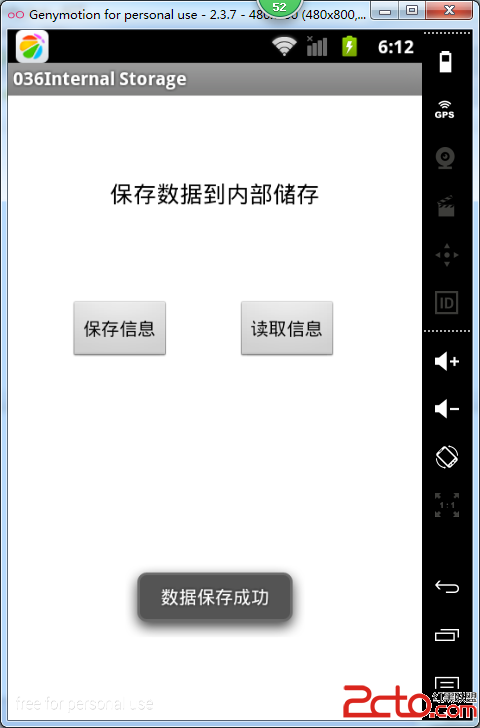編輯:關於Android編程
In order to reuse the Fragment UI components, you should build each as a completely self-contained, modular component that defines its own layout and behavior. Once you have defined these reusable Fragments, you can associate them with an Activity and connect them with the application logic to realize the overall composite UI.
Often you will want one Fragment to communicate with another, for example to change the content based on a user event. All Fragment-to-Fragment communication is done through the associated Activity. Two Fragments should never communicate directly.
Define an Interface
To allow a Fragment to communicate up to its Activity, you can define an interface in the Fragment class and implement it within the Activity. The Fragment captures the interface implementation during its onAttach() lifecycle method and can then call the Interface methods in order to communicate with the Activity.
Here is an example of Fragment to Activity communication:
public class HeadlinesFragment extends ListFragment {
OnHeadlineSelectedListener mCallback;
// Container Activity must implement this interface
public interface OnHeadlineSelectedListener {
public void onArticleSelected(int position);
}
@Override
public void onAttach(Activity activity) {
super.onAttach(activity);
// This makes sure that the container activity has implemented
// the callback interface. If not, it throws an exception
try {
mCallback = (OnHeadlineSelectedListener) activity;
} catch (ClassCastException e) {
throw new ClassCastException(activity.toString()
+ " must implement OnHeadlineSelectedListener");
}
}
...
}
Now the fragment can deliver messages to the activity by calling the onArticleSelected() method (or other methods in the interface) using the mCallback instance of the OnHeadlineSelectedListener interface.
For example, the following method in the fragment is called when the user clicks on a list item. The fragment uses the callback interface to deliver the event to the parent activity.
@Override
public void onListItemClick(ListView l, View v, int position, long id) {
// Send the event to the host activity
mCallback.onArticleSelected(position);
}
Implement the Interface
In order to receive event callbacks from the fragment, the activity that hosts it must implement the interface defined in the fragment class.
For example, the following activity implements the interface from the above example.
public static class MainActivity extends Activity
implements HeadlinesFragment.OnHeadlineSelectedListener{
...
public void onArticleSelected(int position) {
// The user selected the headline of an article from the HeadlinesFragment
// Do something here to display that article
}
}
Deliver a Message to a Fragment
The host activity can deliver messages to a fragment by capturing the Fragment instance with findFragmentById(), then directly call the fragment's public methods.
For instance, imagine that the activity shown above may contain another fragment that's used to display the item specified by the data returned in the above callback method. In this case, the activity can pass the information received in the callback method to the other fragment that will display the item:
public static class MainActivity extends Activity
implements HeadlinesFragment.OnHeadlineSelectedListener{
...
public void onArticleSelected(int position) {
// The user selected the headline of an article from the HeadlinesFragment
// Do something here to display that article
ArticleFragment articleFrag = (ArticleFragment)
getSupportFragmentManager().findFragmentById(R.id.article_fragment);
if (articleFrag != null) {
// If article frag is available, we're in two-pane layout...
// Call a method in the ArticleFragment to update its content
articleFrag.updateArticleView(position);
} else {
// Otherwise, we're in the one-pane layout and must swap frags...
// Create fragment and give it an argument for the selected article
ArticleFragment newFragment = new ArticleFragment();
Bundle args = new Bundle();
args.putInt(ArticleFragment.ARG_POSITION, position);
newFragment.setArguments(args);
FragmentTransaction transaction = getSupportFragmentManager().beginTransaction();
// Replace whatever is in the fragment_container view with this fragment,
// and add the transaction to the back stack so the user can navigate back
transaction.replace(R.id.fragment_container, newFragment);
transaction.addToBackStack(null);
// Commit the transaction
transaction.commit();
}
}
}
 在Android中調用WebService實例
在Android中調用WebService實例
某些情況下我們可能需要與Mysql或者Oracle數據庫進行數據交互,有些朋友的第一反應就是直接在Android中加載驅動然後進行數據的增刪改查。我個人不推薦這種做法,一
 android 讀取WebView緩存及清理WebView緩存
android 讀取WebView緩存及清理WebView緩存
WebView中存在著兩種緩存:網頁數據緩存(存儲打開過的頁面及資源)、H5緩存(即appcache)。一、網頁緩存1、緩存構成/data/data/package_na
 Android文件存儲的問題:ClassLoader和實現Parcelable接口後 詳解及用途
Android文件存儲的問題:ClassLoader和實現Parcelable接口後 詳解及用途
可能小伙伴們讀了我上一篇博客關於Android文件存儲的的,在文件操作的時候大家有沒有疑問呀,有就對了,可能在保存自定義對象的時候,如何序列化呀?ClassLoader到
 從零開始學android(數據存儲(2)Internal Storage內部存儲.三十六.)
從零開始學android(數據存儲(2)Internal Storage內部存儲.三十六.)
Call openFileOutput() with the name of the file and the operating mode. This return